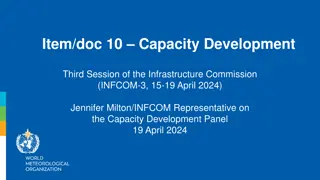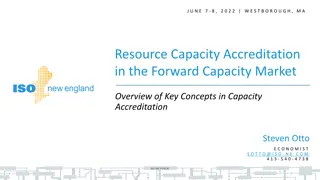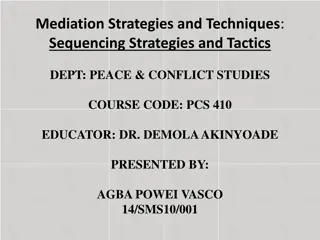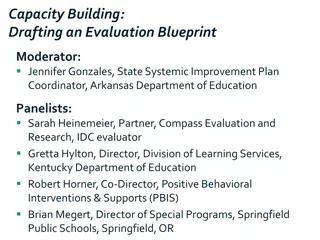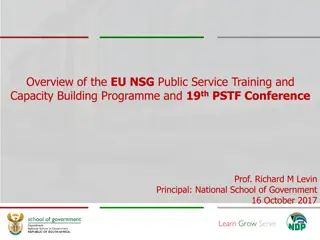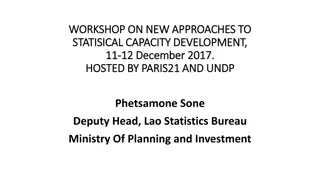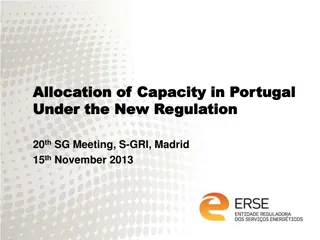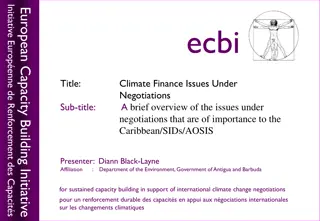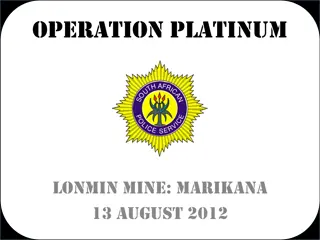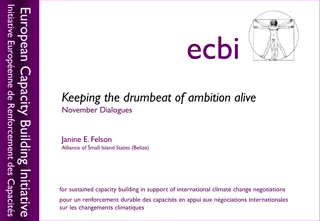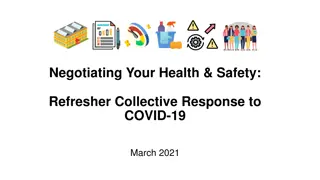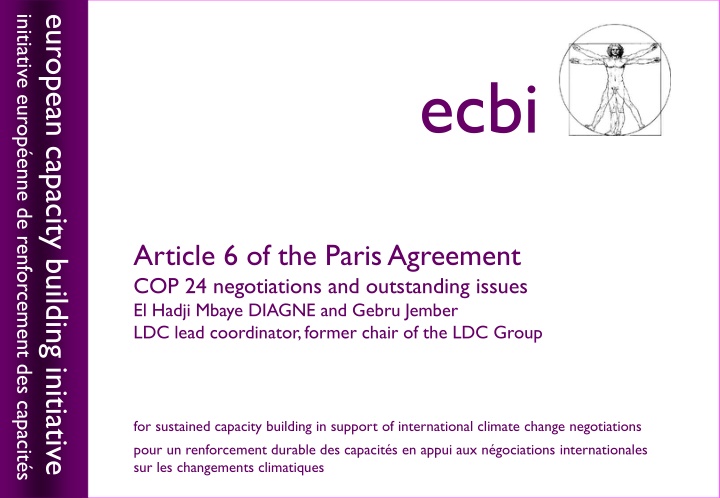
Article 6 of the Paris Agreement and Mechanisms for Climate Change Mitigation and Sustainable Development
Learn about the European Capacity Building Initiative (ECBI) and the pivotal role of Article 6 in the Paris Agreement negotiations, focusing on cooperation mechanisms, mitigation outcomes, and support for sustainable development. Explore key differences between the Market Mechanisms of the Kyoto Protocol and the Mitigation and Sustainable Development Mechanism (MSDM) under Article 6.4 and 6.7, emphasizing the mobilization of the private sector for climate action.
Download Presentation

Please find below an Image/Link to download the presentation.
The content on the website is provided AS IS for your information and personal use only. It may not be sold, licensed, or shared on other websites without obtaining consent from the author. If you encounter any issues during the download, it is possible that the publisher has removed the file from their server.
You are allowed to download the files provided on this website for personal or commercial use, subject to the condition that they are used lawfully. All files are the property of their respective owners.
The content on the website is provided AS IS for your information and personal use only. It may not be sold, licensed, or shared on other websites without obtaining consent from the author.
E N D
Presentation Transcript
initiative europenne de renforcement des capacits european capacity building initiative ecbi ecbi european capacity building initiative Article 6 of the Paris Agreement COP 24 negotiations and outstanding issues El Hadji Mbaye DIAGNE and Gebru Jember LDC lead coordinator, former chair of the LDC Group for sustained capacity building in support of international climate change negotiations pour un renforcement durable des capacit s en appui aux n gociations internationales sur les changements climatiques
Background: Article 6 mechanisms The Paris Agreement recognize that Parties may choose, on a voluntary basis, to cooperate in the implementation of their NDCs: ecbi european capacity building initiative to allow for higher ambition in their mitigation and adaptation actions and to promote sustainable development and environmental integrity (Art. 6.1) This can be done through three approaches / mechanisms: Cooperatives approaches (Art. 6.2 Art. 6.3) Parties can cooperate directly with one another (Art. 6.2). Cooperation that involve an international transfer of mitigation outcomes (ITMOs)
Background: Article 6 mechanisms (2) Mechanism for mitigation and sustainable development (Art. 6.4 Art. 6.7) ecbi european capacity building initiative which produces mitigation outcomes and support sustainable development; which operates under the authority of the COP; requires mitigation action to be additional, real, measurable, long term, additional, real, measurable, long term, as well as to be verified By designated operational entities; as well as to be verified By designated operational entities; mitigation outcomes that can then be used to fulfil the NDC of another Party. unique aspect is its goal of mobilizing the private sector to participate in climate change mitigation by providing suitable incentives. The Paris Agreement will thus offer actors at sub-national level an opportunity to directly use the mechanism established under Article 6.4.
Background: Article 6 mechanisms (2) Although there are many similarities between the MSDM and the market mechanisms under the Kyoto Protocol(KP), there are a number of important differences. For instance: (1) While the CDM distinguishes distinguishes between between Annex reductions (CERs)) And non non Annex Annex I I Parties Parties (host mitigation projects),this dropped dropped from from the the MSDM MSDM; ; (2) The CDM is project project- -based based (later redefined by the EB as programmes number of similar projects),where as the MSDM MSDM does activities activities but requests that the eligible scope be further specified; (3) The CDM is an offset offset mechanism mechanism, which, from a global perspective, does contribute contribute to to reducing reducing global global GHG GHG emissions emissions. By contrast, the MSDM is subject to a provision stating that it shall shall aim aim to to mitigate mitigate global global emissions emissions overall ecbi european capacity building initiative Annex I I Parties (acquire certified emissions this distinction distinction has has been been programmes, which can include a not specify specify the the scope scope of of the does not the mitigation mitigation does not not directly directly overall. Framework for non-market approaches (Art 6.8 & 6.9) Promote mitigation and adaptation ambition; Enhance public and private participation in the implementation of Parties NDCs; and Enable opportunities for coordination across instruments and relevant institutional arrangements. As the name suggests, market-based climate change mechanisms play no role at all. Just how these non-market-based approaches are to work will be determined in the coming years with the development of a framework for non-market-based approaches .
Article 6 of the P.A. at COP 24 in Katowice (1) At COP 21, SBSTA was mandated to: Develop guidance for Cooperatives Approaches (6.2 &6.3); Develop rules, modalities and procedures for the Mechanism for mitigation and Sustainable Development (6.4 to 6.7); Recommend a draft decision on the work programme under the framework for non-market approaches to sustainable development (6.8 & 6.9). ecbi european capacity building initiative At COP 24, adopted Paris Rulebook at COP 24 without article 6 In Katowice, Article 6 negotiations under SBSTA 49: Draft decision on the 3 agenda sub-items: Addressed technical issues and forwarded political issues to the ministerial consultation Many options for each issue and many brackets for some options Ministerial consultations: LDC ministers not enough involved in the consultations Streamlined text with still options and brackets
Article 6 of the P.A. at COP 24 in Katowice (2) Proposal by the COP presidency Not accepted Decision deferred to COP 25: ecbi european capacity building initiative Completion of the Paris rulebook having a procedural d cision on article 6; SBSTA mandated to complete the work and to submit recommandations to COP 25; Next negotiations will be conducted taking into consideration 2 sets of texts (SBSTA 49 draft CMA decision on Article 6 and the draft decision texts on these matters in the proposal by the President); L23 & L24 (withdraw) were not used in the final Katowice decision-presidency texts Both presidency and SBSTA sets of documents with many options and brakets within options.
Article 6 of the P.A. at COP 24 in Katowice (3) Recognition of special circumstances of LDCs and SIDS in relation to their NDCs and other aspects; Substantial progress, but many critical issues remained; Brazil generally seen as responsible for failure due to inflexibility on corresponding adjustments and CDM transition; In reality deep divergences between different groups due to: Different types of NDCs: o Economy wide, single and multiple years, deviation from BaU, sectoral, policies, etc . Governance of 6.2 Mechanism: o Level of oversight from UNFCCC; o Upfront assessment/review or only ex-post review Accounting and corresponding adjustment; Contribution to Adaptation (share of proceeds); Overall mitgation in global emissions (OMGE); Future of KP mechanisms. ecbi european capacity building initiative
Outstanding issues related to article 6.2 (1) Scope Eligibility of sectors and gases inside and outside NDCs o NDCs prepared before rules of article 6; o lack of information and MRV framework; o Incentive for progression o Eligibility with safeguards to ensure environmental integrity, promote SD and avoid double counting; o Environmental integrity and avoiding perverse incentives o Sectors and gases inside and outside NDCs but subject to corresponding adjustment o Inclusion of the land sector in Article 6 : Article 6.2 and 6.4 open for all NDC types and sectors that meet the guidance. Specific sectors (such as the land sector or REDD+) do not need to be explicitly referenced in Article 6 guidance No use of ITMOs outside of UNFCCC (for ex. CORSIA-aviation) o ITMOs are not fungible units. ecbi european capacity building initiative
Outstanding issues related to article 6.2 (2) Governance Article 6 or Article 6.2 Body Compromise position in Katowice: o If no have an Art. 6.2 body / Art. 6 body; ** Have an article 6.2 technical expert review team; ** Annual report on article 6.2 activities by the Secretariat Requirement to have a registry for Art. 6.2 activities and an international registry (Secretariat) that countries can use if they don t have their own. Share of proceeds ecbi european capacity building initiative o Share of proceeds is needed under 6.2 and 6.4 to ensure support for adaptation and an equal treatment across Article 6.
Outstanding issues related to article 6.2 (3) Corresponding adjustment Corresponding adjustments for ITMOs inside and outside NDCs Corresponding adjustment for ITMOs used for purposes other than toward a country s NDC (e.g., CORSIA) starting in 2020. Tracking, reporting and review of ITMOs Registry required for Art. 6.2 participation, with the UNFCCC Secretariat providing a central registry for those countries not having an own one; Report ITMOs in Biennial Transparency Report (BTR) o Para 77d of the Article 13 decision in Katowice (Reporting under the Transparency Framework): controversial for article 6 negotiations ecbi european capacity building initiative
Outstanding issues related to article 6.4 (1) Governance Supervisory Body for Art. 6.4 similar to CDM EB CDM model + LDC representative Paris model-inclusive A grievance mechanism for Art. 6.4 ?-CDM do not have Scope: Activities inside and outside NDCs o The aim of 6.4 mechanism is to generate certified units; transactions will be under 6.2. Article 6.4 activities cycle: CDM activities cycle with simplifications (validation- registration-verification-issuance) Transition of KP infrastructures and methodologies: Transition of CDM infrastructure and methodologies, subject to refinement. ecbi european capacity building initiative
Outstanding issues related to article 6.4 (2) Transition of existing CDM projects to the mechanism under Article 6.4 Transition of KP units provided that activities meet the requirements (to be developed) under Article 6.4 by 2023; Once transitioned, the activities must be treated as Article 6.4 activities for the rest of its crediting life. ecbi european capacity building initiative Use of pre-2020 units toward NDCs or under Article 6 Units generated before 2020 cannot be used to toward an NDC. This must be explicit in the text (no silence on this matter). LDCs won t benefit much from pre-2020 units being allowed; Emerging countries could flood the market with pre-2020 units.
Outstanding issues related to article 6.4 (3) Share of proceeds: Share of proceeds is needed under 6.2 and 6.4 to ensure support for adaptation and an equal treatment across Article 6; Technical studies on operationalization needed. ecbi european capacity building initiative Overall Mitigation of Global Emissions (OMGE): Support the principle of overall mitigation through the use of conservative baselines or voluntary cancellation; approaches that require discounting or automatic cancellation of units. Share of proceeds and OMGE should be delinked within the negotiations, as they are separate issues for which we want to see different outcomes.
Outstanding issues related to article 6.8 Governance arrangements: Option A {agenda item(s) of subsidiary body(ies) without creation of a new body}:- o Option A1 {SBSTA agenda item with determination of the need for governance arrangements after the completion of certain activities of the work programme} o Option A2 {NMA forum with determination of the need for governance arrangements after the completion of certain activities of the work programme} Option B: o Task force held in conjunction with the meetings of the SBSTA ecbi european capacity building initiative
Further technical studies needed Modalities for corresponding adjustment in relation of different types of NDCs and implications Single and multiple years for economy wide absolute emissions reductions Activities outside NDCs (with and without a deadline) ecbi european capacity building initiative Avoiding double counting: In relation to activities outside Parties NDCs In relation to activities outside UNFCCC (ICAO, IMO, etc ) Operationalization of share of proceeds; Operationalization of OMGE; Options for the transition of KP units and registered projects and programmes (vintage, discount, deadline, cut of date, etc ) and impacts in the global ambition; Domestic and international registry for article 6.2 Different type of cooperation (linkage of ETS, bilateral /multilateral crediting activities, subsequent transfers, etc .)
ecbi european capacity building initiative Thank you for your attention emdiagne@Hotmail.com Gebru_j@yahoo.com

